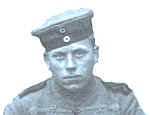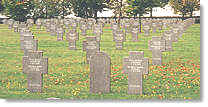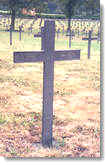 With the end of the First World War the upkeep of German military
cemeteries in France and Belgium came to an abrupt end. Organisations
attached to the German army which had looked after the graves during the
war were disbanded. The only official military war grave organisation
operative after 1918 was the Central-Nachweise-Amt, a bureau in
the Prussian war ministry. Under the terms of the Versailles Treaty the
responsibility of this bureau for the maintenance of German military
cemeteries outside Germany's borders was taken out of its hands and
handed over to the governments of the respective countries where German
soldiers were buried.
With the end of the First World War the upkeep of German military
cemeteries in France and Belgium came to an abrupt end. Organisations
attached to the German army which had looked after the graves during the
war were disbanded. The only official military war grave organisation
operative after 1918 was the Central-Nachweise-Amt, a bureau in
the Prussian war ministry. Under the terms of the Versailles Treaty the
responsibility of this bureau for the maintenance of German military
cemeteries outside Germany's borders was taken out of its hands and
handed over to the governments of the respective countries where German
soldiers were buried.
In 1919 Dr. Siegfried Emmo Eulen,
a former army officer who had been in charge of military burials in
Poland and Turkey, brought together a group of like-minded individuals
to set up an voluntary association to look after the German military
graves outside Germany. He believed that the organisation should be
privately funded and non-political, and that membership should be open
to all.
Dr Eulen's call for action won support
from influential politicians, literary figures and artists. The new
association was named the 'Deutsche Kriegsgräberfürsorge' –
literally translated as 'Care for German War Graves' – and the
founding committee meeting took place on 26 November 1919. To ensure
that the German people were aware that anyone could become a member of
the association, that is, that there was no limitation on certain
classes or political persuasions the word 'Volksbund', meaning 'people's
association', was added on 13 December 1919, giving the organisation the
full title of 'Volksbund Deutsche Kriegsgräberfürsorge'. On 16
December 1919 the first membership meeting was held in Berlin and the
huge task of the association began.
Aims
 The
constitutional aims of the newly created Volksbund were: The
constitutional aims of the newly created Volksbund were:
- to construct and maintain
cemeteries both abroad and in Germany.
- to arrange for remembrance wreaths
to be placed on behalf of next of kin.
- to provide financial support for
relatives' pilgrimages to graves.
- to offer help and advice to
dependants concerning any matters relating to the soldier's resting
place.
- to establish a constructive liaison
with the appropriate authorities in whose land the German soldiers
were buried, and to be the means to learn from the past, to build
bridges of friendship and to spread the word of peace.
The Volksbund Motif
The first publication of the magazine
of the association 'Stimme und Weg' was in early 1921. The front
cover featured a photograph of the 'Vier-Grenadier-Grab' – the
'Four Grenadiers Grave' – in Poland which was designed by Dr. Eulen.
The military graves have been removed from this cemetery over the years,
and all that remains now is the overgrown raised dias on which the
crosses stood.
The image of these crosses was created
into a graphic motif in 1926 by Professor Böhm and has been used more
or less in the same form as the Volksbund's motif ever since. The
magazine is still published for the membership and to advertise the work
of the Volksbund.
Building the Cemeteries after the
First World War
 By
1929 the Volksbund had completed a survey which estimated that 28
countries contained about 13,000 German military cemeteries, ranging
from large plots to individual graves. Almost 930,000 – about 50% of
the total German military losses – were buried in France, where the
cemeteries roughly followed the line of the trenches which had divided
the opposing sides on the Western Front. In Belgium there were 134,000
German dead, in Poland 400,000, in the Soviet Union 115,000. By
1929 the Volksbund had completed a survey which estimated that 28
countries contained about 13,000 German military cemeteries, ranging
from large plots to individual graves. Almost 930,000 – about 50% of
the total German military losses – were buried in France, where the
cemeteries roughly followed the line of the trenches which had divided
the opposing sides on the Western Front. In Belgium there were 134,000
German dead, in Poland 400,000, in the Soviet Union 115,000.
- Only about
one tenth of the 1,937,000 German soldiers killed in the Great War were
buried on German soil. (It might be remembered that no Australian
war-time graves were in Australia).
In the early years the Volksbund had
little opportunity to work on cemeteries outside Germany. Nevertheless,
they made useful contacts with people outside Germany to find out what
state the cemeteries were in and to lay wreaths on behalf of German
families if possible.
After the Second World War there were
huge new problems – worldwide – for the Volksbund to overcome. They
had to start again from scratch with the task of taking the losses of
the Second World War into their care. Yet again the German government
had to establish a delicate liaison with all the nations where German
military and civilian dead were buried.
In 1966
the Federal Republic of Germany signed an agreement with France enabling
the Volksbund to start work again in France. It was important to get
straight to work on the hundred or so First World War cemeteries which
they had not managed to construct before the outbreak of the Second
World War and which had been more or less abandoned for thirty years.
Mass graves were provided with new
tablets to show the soldiers names, memorials were erected and
vegetation replanted. Directional signs to the cemeteries were renewed
– many had been damaged by vehicles and vandalism over the years.
Renovations to the last of these cemeteries was finally finished in
1980.
Design and Construction
 In
June 1926 the architect Robert Tischler formed a construction
team initially based in Munich (it moved to Kassel in 1967) to take on
the task of erecting and building memorials and cemeteries. It was
decided not to have a single architectural scheme like the British,
American and French style of uniform gravestone, cross of sacrifice or
national flag. Instead, the plan was to set out the gardens and
memorials so that they would blend in with the natural features of the
local area as far as possible. In
June 1926 the architect Robert Tischler formed a construction
team initially based in Munich (it moved to Kassel in 1967) to take on
the task of erecting and building memorials and cemeteries. It was
decided not to have a single architectural scheme like the British,
American and French style of uniform gravestone, cross of sacrifice or
national flag. Instead, the plan was to set out the gardens and
memorials so that they would blend in with the natural features of the
local area as far as possible.
From the beginning the consideration
for the long-term was very important to the Volksbund. Robert Tischler
and the team were given a task to construct the cemeteries using
architectural and horticultural features which would preserve the theme
of 'Remembrance', as a reminder of what had happened. At the same time
the team had to consider the need for low-cost maintenance. Gardening
had to be kept to a minimum, bearing in mind that in most cases the
goodwill and assistance of local volunteers had to be relied on for
regular maintenance like mowing the grass.
The Volksbund Today
The work of the Volksbund is now
officially carried out on behalf of the German government although the
Volksbund is still funded by donations from the German people and the
membership. For more information visit www.volksbund.de |